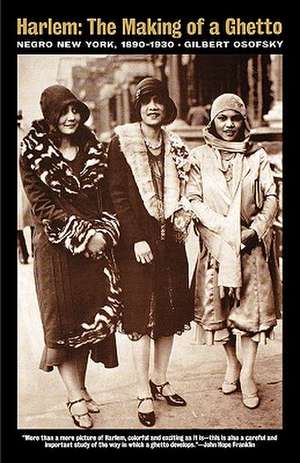Harlem
Autor Gilbert Osofskyen Limba Engleză Paperback – 24 feb 1996
Preț: 110.10 lei
Nou
Puncte Express: 165
Preț estimativ în valută:
21.08€ • 21.52$ • 17.74£
21.08€ • 21.52$ • 17.74£
Carte tipărită la comandă
Livrare economică 25 februarie-11 martie
Preluare comenzi: 021 569.72.76
Specificații
ISBN-13: 9781566631044
ISBN-10: 1566631041
Pagini: 302
Dimensiuni: 140 x 216 x 16 mm
Greutate: 0.33 kg
Ediția:2. Auflage.
Editura: Ivan R. Dee Publisher
ISBN-10: 1566631041
Pagini: 302
Dimensiuni: 140 x 216 x 16 mm
Greutate: 0.33 kg
Ediția:2. Auflage.
Editura: Ivan R. Dee Publisher
Notă biografică
Cuprins
Part 1 Preface ix Part 2 Preface to the Second Edition xiii Part 3 PART ONE: THE NEGRO AND THE CITY Chapter 4 "No Crystal Stair": Negro New York, the 1890's 3 Chapter 5 "Come Out from Among Them": Negro Migration and Settlement, 1890-1914 17 Chapter 6 Alienation: New York and the Negro 35 Chapter 7 Urban Progressives: Negro and White 53 Part 8 PART TWO: THE MAKING OF A GHETTO Chapter 9 A Genteel Community: Harlem, 1890 71 Chapter 10 The Other Harlem: Roots of Instability 81 Chapter 11 Race Enterprise: The Afro-American Realty Company 92 Chapter 12 A Neighborhood Transformed 105 Part 13 PART THREE: HARLEM SLUM Chapter 14 Harlem Tragedy: An Emerging Slum 127 Chapter 15 "Harlem Must Be Saved": The Perpetual Frontier 150 Chapter 16 A Taste of Honey: Ward Politics 159 Part 17 Epilogue: Symbols of the Jazz Age- The New Negro and Harlem Discovered 179 Part 18 Retrospect: The Enduring Ghetto 189 Part 19 Bibliographical Essay 203 Part 20 Notes 215 Part 21 Index 265
Textul de pe ultima copertă
A great many books have been written about Harlem, but for social history none has surpassed Gilbert Osofsky's account of how a pleasant, pastoral upper-middle-class suburb of Manhattan turned into an appalling black slum within forty years. Mr. Osofsky sets his chronicle against the background of pre-Harlem black life in New York City and in the context of the radical changes in race relations in America in the late nineteenth and early twentieth centuries. He traces Harlem's change to the largest segregated neighborhood in the nation and then its fall to a slum. Throughout he neatly balances statistics and humanly revealing details.









